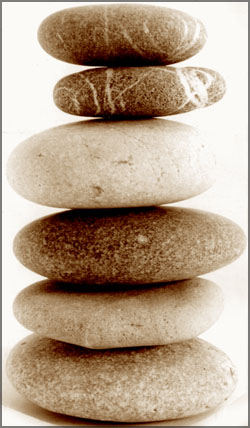A balancing act
Achieving balance in your life and that of your
family is of paramount importance...
In today's world, the word "balance" has become a buzz word. Unlike
in the past when it merely meant what dictionaries proclaimed it to
mean, busy mothers and fathers seek "better balance" between work and
family, family and friends, time to spend with each other and alone time
when you could simply relax and rejuvenate.
In fact, many parents say with conviction that life as it is today,
can feel like one big balancing act.
But reverting to its original meaning, helping your child achieve
good balance - literally - is equally vital. Balance is the stronghold
contributing to every skill we have and because children today are
bending over laptop computers and video games and shouldering heavy
backpacks to school, their balance is more challenged than ever. the stronghold
contributing to every skill we have and because children today are
bending over laptop computers and video games and shouldering heavy
backpacks to school, their balance is more challenged than ever.
Continuously hunching over or carrying extra weight can affect
posture and balance which could lead to less success in sports, problems
in the way the child carries himself and walks which in turn contribute
to social problems when he or she is teased in school about his "funny
walk" or "slouch."
Why has this become an issue today? M&M talked with a few experts who
confirm that bad posture causes most of the problems.
With more kids becoming housebound and indulging in sedentary
activities such as working on computers, focusing more on bookwork and
studies in an increasingly competitive environment, playing video games
and watching DVDs, the problem is compounded.
Games like Hop Scotch and "Hop and Catch" promote balance but sadly
these games seem to be dying out of a child's itinerary today except
perhaps in the more rural areas of Sri Lanka where children have more
garden space in which to play.
City bound and apartment living children have the option of attending
kid-level classes in balance building activities which include Yoga and
Karate which are gaining immensely in popularity today. But there are
also simple exercises families can do at home to boost stability.
Why this focus on balance? Is it all that important? Why practise
something so basic? More and more researchers are connecting balance to
mental, not just physical functioning.
When children stabilize themselves from an unstable post, they learn
how to focus faster and more efficiently. In fact, children with
learning problems who often have less than optimal balance, can
particularly benefit from balance training.
Although babies develop differently and their stages of development
do not fit in to perfect compartments, you could expect him to achieve
head control when he is around 2 months. He will probably start sitting
up when he is between 6 to 7 months, crawling when he is 8 to 10 months
and standing with support when he is around 9 to 10 months.
Baby might stand independently any time between 9 to 16 months and
start walking around this same time. He could run smoothly at 21 to 30
months, hop on one foot when he is 4 to 5 years and start skipping when
he is between 5 and 6 years. Remember, these are generalised and your
baby's development might vary dramatically, making him a slow or early
starter, and this is generally nothing to worry about.
When your baby is between 6 months to 1 year and has begun to sit up,
let her grab the fingers of both your hands and pull herself in to a
sitting position. Once she is seated, slowly move your hands towards
her, just enough so that she has to rely on her own sense of balance.
When your child is between 1 to 3 years you could sit down in a chair
and have your child stand in front of you with his arms extended out
from his sides. Reach your hands underneath his arms but don't support
his weight. Just have them ready so you can catch him if he loses his
balance. Ask him to step up on to the tops of your shoes. Make a game of
how long he can balance himself on your feet.
You could both achieve better balance when you stand together with
your feet apart, hands on hips. Stand on your left leg, bending the
right leg slightly behind you like a stork. Hold this pose for two
seconds, then slowly extend your right leg straight out and slightly in
front of you without touching the ground. Hold for two seconds and
repeat the exercise standing on the right leg.
Once this begins to feel easy, you could try extending your arms out
in front of you or overhead. Playing "Simon Says" with your child can
make this exercise even more fun.
Because balance can be bolstered from infancy, you should ask your
doctor to direct you to the right place where you could be guided on
exercises for children. If your child is very young - say under a year -
remember to place soft pillows in and around the exercise area.
An added plus point is that it is never too late to enhance your own
sense of equilibrium. Learning balance is an ongoing practice and
practising together can give your child a sense of mutual support while
developing your own sense of balance in many ways.
By courtesy Mum and Me
|
